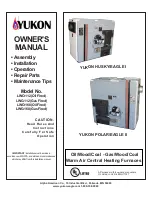
508134-01
Issue 2045
Page 20 of 56
Blower Compartment
Each blower is statically and dynamically balanced as
an assembly before installation in the unit.
IMPORTANT
A93DF1E / 92G1DFE units are equipped with a constant
torque ECM motor. It has a DC motor coupled to an
electronic control module both contained in the same motor
housing. The motor is programmed to provide constant
torque at each of the five selectable speed taps. Each tap
requires 24 volts to energize.
Input Voltage Requirements
The circuit is designed to be operated with AC voltage. To
enable a tap requires 12 to 33VAC. Expected current draw
will be less than 20mA.
Troubleshooting the Motor
Troubleshooting the motor is an easy process. Follow
steps below.
1.
Shut off power to unit.
2.
Remove input plugs P48 and P49 from motor. See
Figure 16 for troubleshooting procedure.
If correct voltage is present in tests 1 and 2 and motor is
not operating properly, replace motor. The motor is not field
repairable.
If replacing the indoor blower motor or blower wheel is
necessary, placement is critical. The blower wheel must
be centered in the blower housing as shown in Figure 13.
When replacing the indoor blower motor the set screw
must be aligned and tightened with the motor shaft as
Secondary Limit Controls
The secondary limit is located in the blower compartment
on the back side of the blower housing. See Figure 15.
When excess heat is sensed in the blower compartment,
the limit will open. If the limit is open, the furnace control
energizes the supply air blower and closes the gas valve.
The limit automatically resets when unit temperature
returns to normal. The secondary limit cannot be adjusted.
Figure 13. Blower Wheel Replacement
Center Blower Wheel
in Blower Housing
Figure 14.
Set Screw
Housing Hub
ALIGN AND TIGHTEN SET SCREW WITH
FLAT SIDE OF MOTOR SHAFT
Motor
Shaft
Figure 15. Secondary Limit Control
Secondary Limits











































